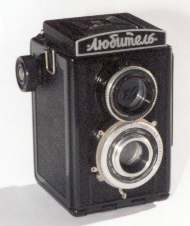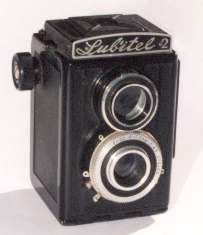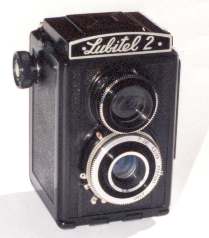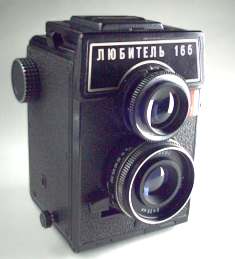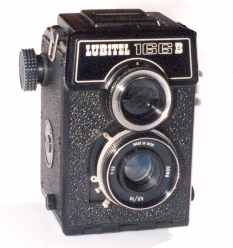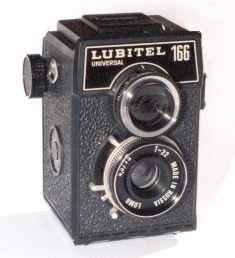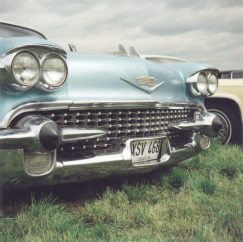 |
|||||||||||||||||||||||||||||||||||||||||||||||||||||||||||||||||||
|
|
|||||||||||||||||||||||||||||||||||||||||||||||||||||||||||||||||||
|
Lubitel / Lubitel 1 This is an original Lubitel, also known as a Lubitel 1. Often described as being closely modeled on the pre-war German Voigtlander Brilliant range, this Lubitel TLR pictured below was the first in a series which were made right up into the 1990s. |
|||||
|
Technical Specifications |
|||||
Lubitel 2These 2 cameras are both examples of the Lubitel 2. The one on the left is an early one, probably from the 1950s or 1960s. The type illustrated on the right had been introduced at least by 1971, however this example is probably as late as 1977. As well as the obvious differences in the inscription, the earlier one has the shutter speeds, 1/10, 1/25, 1/50, 1/100, 1/200 and B (ZT-5 shutter), whilst the later one has the shutter speeds 1/15, 1/30, 1/60, 1/125, 1/250 and B (ZT-8 shutter). Whether shutter timing actually various between the two is questionable.
|
|||||
Lubitel 166This is a Lubitel 166. Very often confused with the much more common Lubitel 166U - the Lubitel 166 is a camera unique in its own right.. Sometime around 1976 the Lubitel 2 was redesigned using a thermoplastic body and the resulting camera was named the Lubitel 166. One notable feature of the new thermoplastic shell was the use of spindles for both film and takeup spools. In the original bakelite body, the film spool just sat loose in a small compartment. According to Princelle this is the end of the story as the camera is otherwise the same as the Lubitel 2. However the camera is most definately NOT just a redesigned Lubitel 2 but as well as having a thermoplastic body also has other new features. The most notable is the lack of a red window, replaced by a proper film counter. Also the shutter is cocked by the process of winding on the film - not seperately like all other Lubitels. |
|||||
Lubitel 166BThis is a Lubitel 166B. Introduced in around 1980, the Lubitel 166B is a simplified version of the Lubitel 166 and indeed is effectively a Lubitel 2 with a thermoplastic body. This example dates from around 1985. Unfortunately the Lubitel 166B retains the use of spindles for both film and takeup spools as introduced with the Lubitel 166. It also retains the Lubitel 166 back catch. Both features which have proved to be weak in actual use. |
|||||
Lubitel 166 UniversalThis is a Lubitel 166 Universal, also known as a Lubitel 166U. Introduced around 1983 this camera was in production until at least the mid 1990s. Originally very similar to the Lubitel 166B, it features an improved back locking device and an insert to allow 6x4.5cm pictures as well. The use of spindles for the film spool was also dropped, either for reasons of cost or the fact they were fiddly and prone to problems! At some point in the models life it was redeigned and later 166U cameras are considerably lighter than earlier ones and vary in small details such as the strap mounts. According to its paperwork, this particular example is from 1996 and is marked, "MADE IN RUSSIA" and is one of the lighter ones. Many Lubitel 166U cameras are however are marked "MADE IN USSR". |
|||||
|
*Note: The viewing lens on all models of lubitel appears to be uncoated |
|
I've not taken many pictures with Lubitels - about 1 roll per camera so far. However my favourite 6x6cm picture was taken with one of my Lubitel 2s, I think probably the older of the pair:
This is a closeup of the far left headlamp. Just to show the Lubitel is capable of decent quality even at the edge of the frame. I didn't record the aperture used - but it must be at least F8. Click HERE for a brief guide to using the Lubitel. For more practical information on using the Lubitel and lots of examples, here are a few places to go: Yahoo Lubitel Group (well worth joining) LUBITEL-PAGE-WUPPERTAL The Lubitel 166 Resource Page |
|
Got a question or can't find the info you are looking for? Click HERE to contact us. |
|
|
|
All text and images Copyright © 2000-2011 Roland Givan, unless otherwise stated. All Rights Reserved. |
|
[Home Page] [Agfa Billy Record II] [Agfa Billy Clack] [Agfa Clack] [Agfa Flexilette] [Agfa Isolette I] [Agfa Isolette II] [Agfa Isolette III] [Agfa Jsolette V] [Agfa Jsolar] [Agfa Karat 6.3] [Agfa Lucimeter S] [Agfa Parat 1] [Agfa Paramat] [Agfa Solinette II] [Agfa Silette] [Agfa Standard] [Agfa Super Isolette] [Agfa Synchro Box] [Boots Bug Camera] [Boots Giraffe Camera] [Boots Polar Bear Camera] [Boots Tiger Camera] [Cat & Mouse Camera] [Doggy Camera] [Cosmic/Smena Symbol] [Epson PhotoPC 650] [Fed 4b] [Fujica Drive] [Homemade 35mm] [Homemade 4x5"] [Iskra] [Komsomolets] [Lubitel Collection] [Minolta Dynax 7000i] [Olympus 35] [Olympus PEN D] [Pingo Camera] [Polaroid Instant 10] [Polaroid i-zone] [Polaroid SLR680] [Polaroid Super Swinger] [Polaroid SX-70] [Praktica Family Camera] [Seagull 4B] [SeaShot Underwater] [Thomas Tank Camera] [Kodak Ultra Sport] [Universal Finder] [Voigtlander Brilliant V6] [Voigtlander Fo. Brilliant] [Yashica 72E] [Yashica Mat] [Zeiss Ikon Contessa 35] ["Zenit"] [Zenit 3M] [Zenit E] [Zenit EM] [Zorki-4K] |
